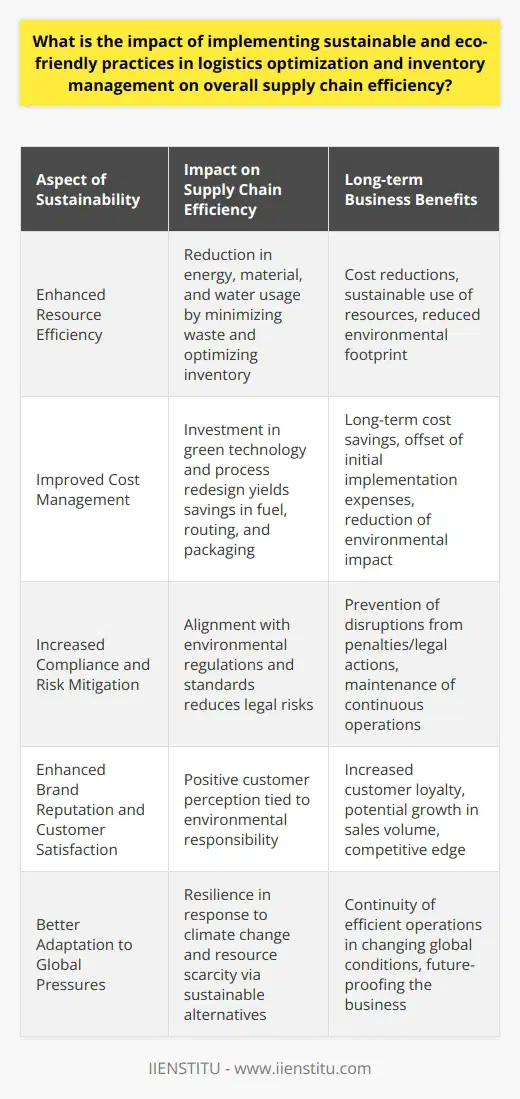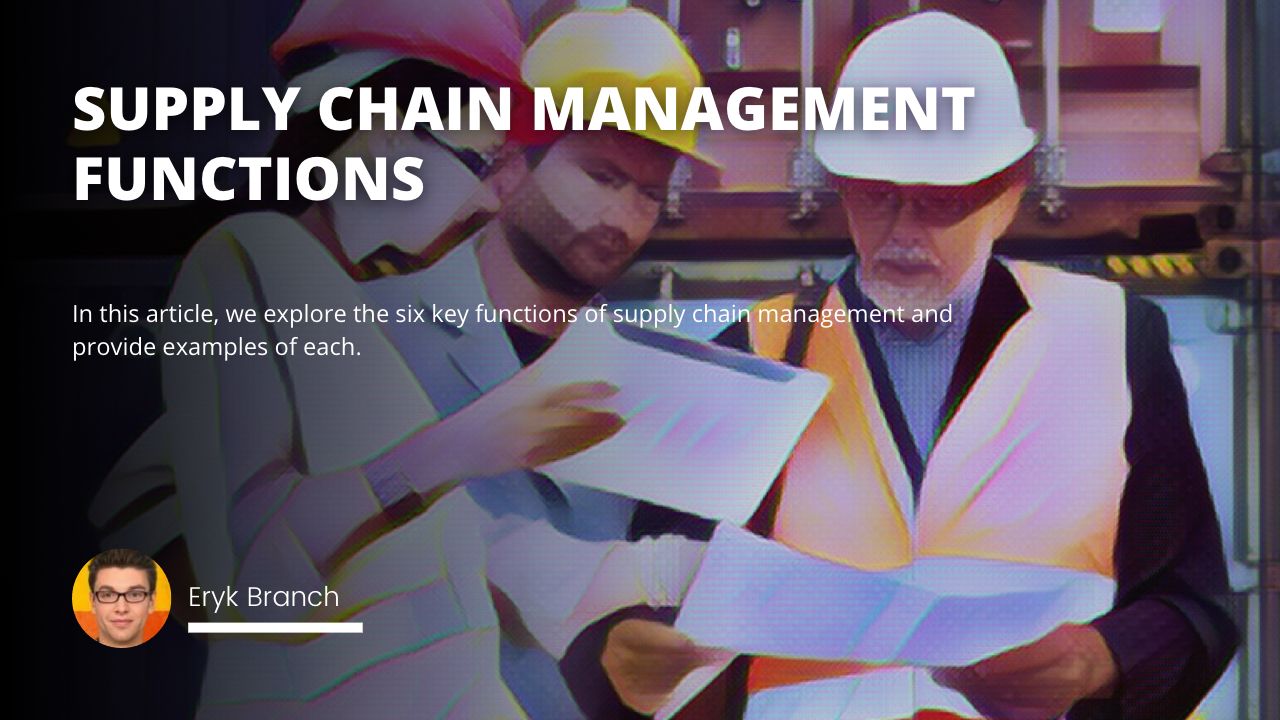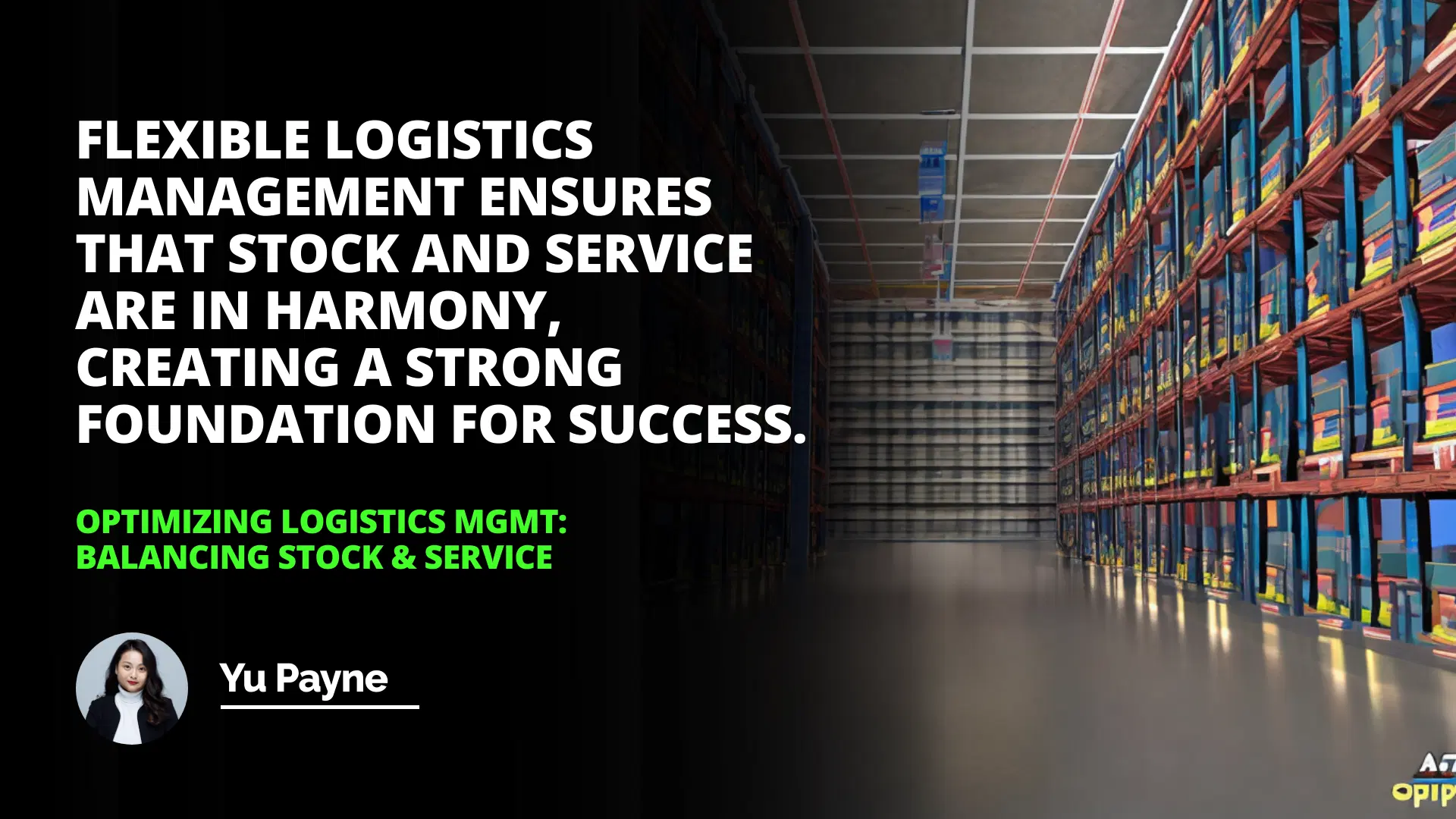
This article discusses the benefits and challenges of centralized inventory control, a strategy used to reduce inventory holding costs and improve customer service. Benefits include reducing administrative costs, improving the accuracy of inventory tracking, reducing the risk of stockouts, and reducing transportation costs.
Challenges include initial investment, increased transportation costs, difficulty managing inventory from a single location, and difficulty managing inventory promptly. Strategies to balance stock and service include implementing an automated inventory management system and negotiating better terms with suppliers.
Introduction
Benefits of Centralized Inventory Control
Challenges of Centralizing Inventory Management
Strategies to Balance Stock and Service
Conclusion
Introduction: Inventory management is a critical part of business operations, closely related to customer service and profitability. Inventory control aims to strike a balance between the inventory level and the desired customer service level. Centralized inventory control is one of the strategies that can be used to achieve this balance.
By reducing field distribution warehouses at multiple locations and consolidating inventory control in a single-mother warehouse, companies can reduce administrative, operating, and manpower costs while simultaneously reducing inventory carrying costs. This article will discuss the benefits of centralized inventory control, the challenges of centralizing inventory management, and strategies to balance stock and service.
Benefits of Centralized Inventory Control
Centralized inventory control has several benefits.
First, it reduces the cost of inventory holding, as fewer warehouses must be maintained, and fewer staff are required to manage the inventory.
Second, it improves the accuracy of inventory tracking and forecasting, as the inventory is managed from a single location.
Third, it helps to reduce the risk of stockouts, as the inventory can be monitored more closely.
Finally, it can help reduce transportation costs, as the inventory can be shipped from a single location.
Challenges of Centralizing Inventory Management
Although centralized inventory control has many benefits, it also poses some challenges.
First, it requires a substantial initial investment to set up the centralized system.
Second, it can lead to increased transportation costs, as the inventory needs to be shipped from a single location.
Third, managing the inventory from a single location can be challenging, as the demand for different products may vary significantly in different locations.
Finally, it can be difficult to manage the inventory promptly, as it needs to be monitored closely to ensure it is available when needed.
Strategies to Balance Stock and Service
In order to balance stock and service, companies need to develop strategies that will enable them to reduce inventory holding costs while still providing an acceptable level of customer service. One such strategy is to implement an automated inventory management system to track inventory levels and alert the company when stock levels fall below a certain threshold.
This will enable the company to replenish the inventory promptly and reduce the risk of stockouts.
Additionally, companies should strive to reduce their inventory holding costs by negotiating better terms with suppliers and utilizing more efficient transportation methods.
Conclusion: In conclusion, centralized inventory control can be a powerful tool for companies to reduce inventory holding costs while providing good customer service. However, companies need to understand the challenges associated with centralized inventory control and develop strategies to balance stock and service.
By implementing an automated inventory management system and negotiating better terms with suppliers, companies can reduce inventory holding costs and ensure that their customers receive the best possible service.
Flexible logistics management ensures that stock and service are in harmony, creating a solid foundation for success.
Related Course: Logistics Course
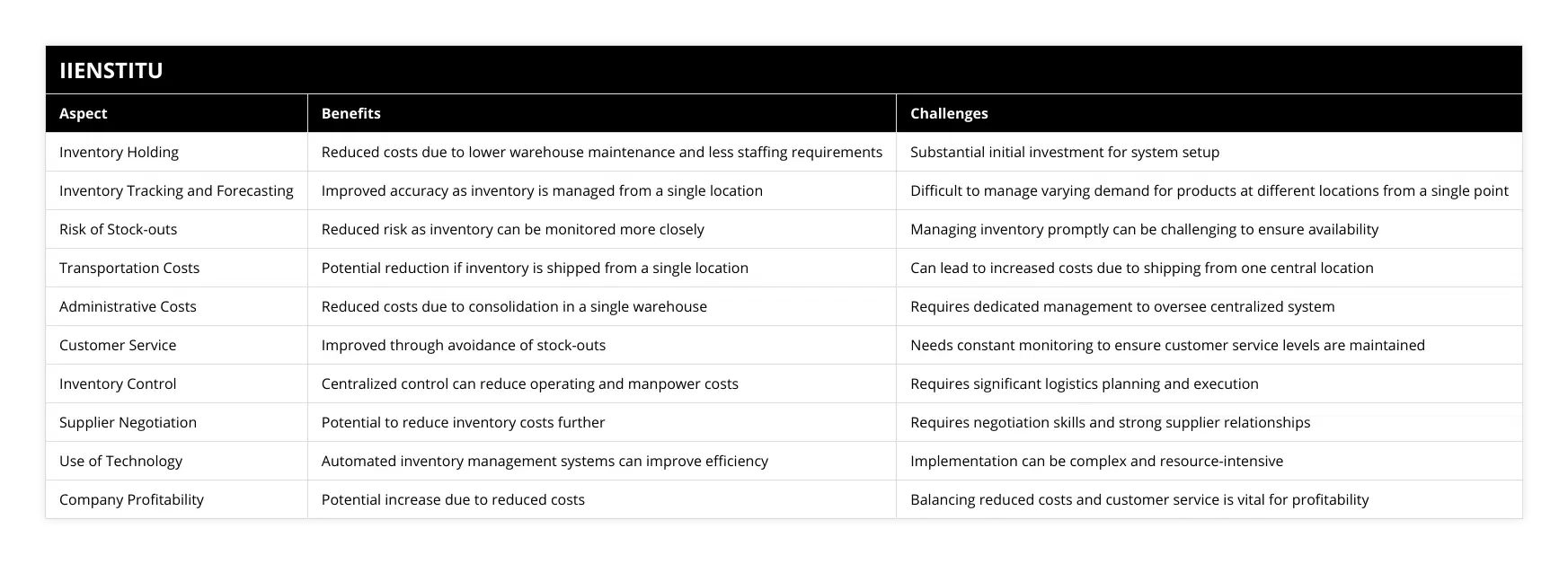
Frequently Asked Questions
What are the benefits of centralized inventory control?
Centralized inventory control is a concept that is gaining traction in many industries, as it allows organizations to manage better the production, distribution, and storage of goods. This inventory control system is beneficial for various reasons, including improved accuracy, increased efficiency, and cost savings.
Accuracy is one of the most significant advantages of centralized inventory control. By having a central system, organizations can quickly and accurately keep track of their stock levels, reducing the need for manual counting and double-checking. This allows for more accurate forecasts, reducing the risk of overstocking or understocking.
Centralized inventory control also allows for increased efficiency. Organizations can more easily manage the production, distribution, and storage of goods by having a central system. This eliminates the need for multiple systems, which can often be costly and time-consuming. Additionally, it reduces the need for manual data entry, which can be time-consuming and lead to errors.
Cost savings is another benefit of centralized inventory control. By having one unified system, organizations can reduce their printing, labeling, and shipping costs. Additionally, they can reduce the costs associated with tracking inventory, as all the data is stored in one central location. This can lead to significant cost savings, which can be reinvested in other business areas.
Overall, centralized inventory control is beneficial for a variety of reasons. It provides organizations with improved accuracy, increased efficiency, and cost savings. This type of system is becoming increasingly popular as organizations look for ways to reduce costs and improve their operations.

What strategies can be used to balance stock and service?
Balancing stock and service is a significant concern for many organizations, especially in the retail industry. Achieving a balance between stock and service requires understanding the customer’s needs, the availability of resources, and the organization's capabilities. This article will discuss some strategies that can be used to balance stock and service to maximize customer satisfaction and profitability.
Strategic Planning
Strategic planning is one of the most important strategies for balancing stock and service. Strategic planning involves developing a comprehensive plan to meet customer needs and maximize profitability. This plan should consider the customer’s preferences and the organization’s resources to determine the most effective way of balancing stock and service. Additionally, the plan should be reviewed periodically to ensure that it still meets customer needs and maximizes profitability.
Inventory Management
Inventory management is another critical strategy for balancing stock and service. Inventory management involves tracking and managing the organization’s stock levels to ensure enough stock to meet customer demands. Additionally, it involves ensuring that stock is not overstocked, which can lead to ineffective use of resources. An effective inventory management system can help organizations maintain the right balance between stock and service.
Customer Service
Customer service is another critical component of balancing stock and service. Organizations must ensure that they provide the highest service to their customers to maximize customer satisfaction and loyalty. This can include providing helpful and knowledgeable customer service representatives, offering convenient payment options, and providing timely delivery of products.
Technology
Technology can also be used to help balance stock and service. Automated systems can manage inventory levels, track customer orders, and process payments. Additionally, technology can provide customers with faster service, such as through online ordering systems.
Conclusion
Balancing stock and service is essential for any organization, especially in the retail industry. Achieving the right balance requires a comprehensive plan, effective inventory management, excellent customer service, and technology. By using these strategies, organizations can maximize customer satisfaction and profitability.
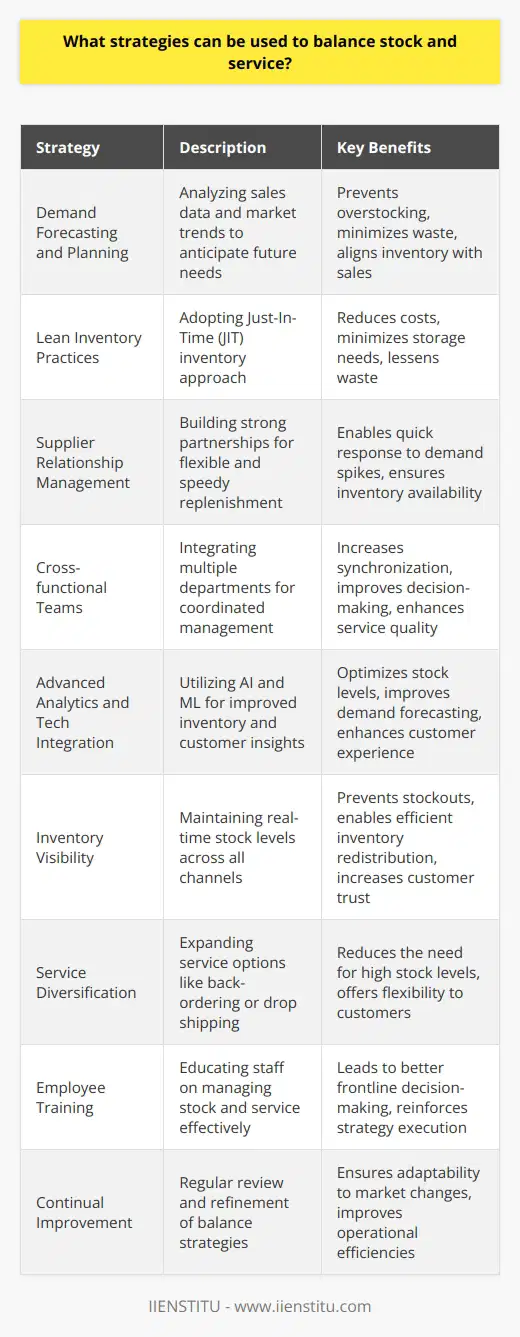
How can businesses overcome the challenges of centralizing inventory management?
Inventory management is a critical component of any business, as it helps ensure that products are available to customers when they need them. However, managing inventory can be challenging, especially for businesses with multiple locations. Centralizing inventory management can help businesses overcome these challenges by providing a single system for tracking inventory and making it available when needed.
One of the main challenges of managing inventory across multiple locations is that each location may have different stock levels and needs. Centralizing inventory management helps to solve this problem by providing businesses with a single system for tracking inventory across all locations.
This system can monitor stock levels, determine when orders need to be placed, and ensure that the right products are in the right locations at the correct times. This can help to reduce the risk of stockouts and ensure that customers can get the products they need when they need them.
Centralizing inventory management can also help to reduce costs. By using a single system to track inventory across multiple locations, businesses can avoid the need for multiple systems and reduce the time and money spent managing inventory.
Additionally, centralizing inventory management can help businesses make better decisions about where to store inventory and when to order new stock. This can help to minimize storage costs and maximize cost savings.
Finally, centralizing inventory management can also help businesses improve customer service. By having a single system for tracking inventory, businesses can quickly identify when an item needs to be ordered and make sure that it arrives promptly.
This can help to ensure that customers are always able to get the products they need when they need them, improving customer satisfaction and helping businesses build customer loyalty.
In conclusion, centralizing inventory management can help businesses overcome the challenges of managing inventory across multiple locations. It can help reduce costs, improve customer service, and ensure that the right products are in suitable locations at the right times.
By implementing a centralized system for inventory management, businesses can ensure that their customers always have access to the products they need when they need them.

How do you optimize inventory management in order to reduce costs and increase efficiency?
**Inventory Analysis and Forecasting**
Optimizing inventory management entails a thorough analysis of current stock levels and accurate forecasting of future demands. By closely monitoring historical sales data and considering seasonal fluctuations, managers can predict customer needs and plan accordingly. This proactive approach helps minimize stockouts and overstock situations, ensuring the right amount of inventory is available at the right time.
**Automation and Technology Utilization**
The implementation of modern Inventory Management Systems (IMS) and warehouse management software can greatly improve the efficiency of stock management. These systems offer real-time data on inventory levels, reducing the risk of human error and allowing for quicker decision-making. Additionally, incorporating technologies such as barcoding and Radio Frequency Identification (RFID) tags facilitate easy tracking and organization of goods, leading to streamlining of warehouse operations.
**Supplier Relationship Management**
Developing strong, collaborative relationships with suppliers is crucial for optimizing inventory management. By communicating closely with suppliers regarding demand forecasts, the procurement process can be more efficient, and delivery times can be reduced. Moreover, a reliable supplier can contribute to minimizing stockouts and ensuring the timely restocking of popular items.
**Just-in-Time (JIT) Inventory**
Adopting a Just-in-Time (JIT) inventory approach allows businesses to cut costs by reducing the amount of stock held in the warehouse. In this method, inventories are ordered as close as possible to when they are needed, avoiding potentially wasteful holding costs. For JIT to function effectively, accurate forecasting and efficient communication with suppliers are essential.
**Regular Inventory Audits**
Performing regular inventory audits is an essential practice in maintaining an accurate and up-to-date account of stock levels. Firms should plan and schedule cycle counts, wherein different sections of the inventory are audited throughout the year. This process enables managers to identify discrepancies, avoid potential stockouts, and address issues that may lead to further inventory problems.
In conclusion, optimizing inventory management requires a combination of accurate forecasting, embracing technology, maintaining strong supplier relationships, adopting efficient inventory methods, and conducting regular audits. These practices will help reduce costs and increase overall operational efficiency.
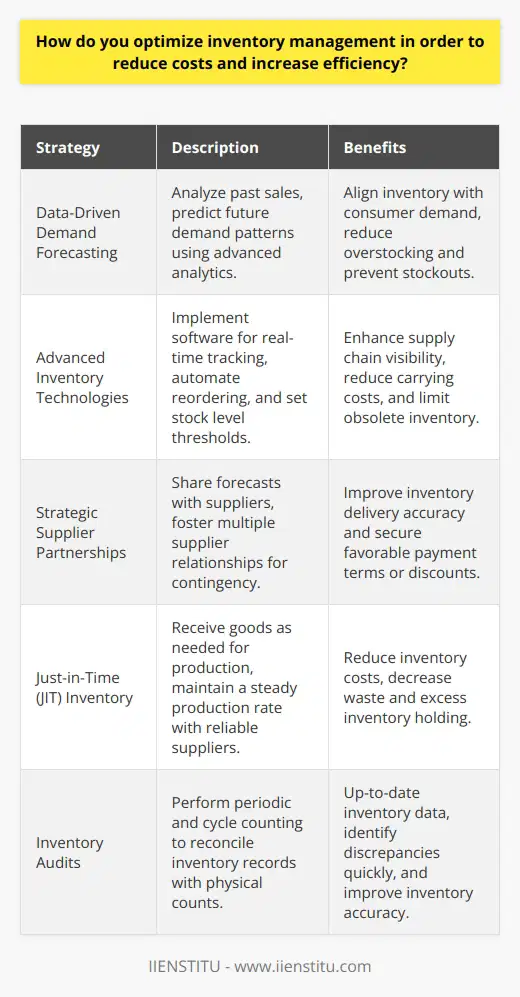
What is inventory optimization logistics and how does it contribute to a successful supply chain?
Inventory Optimization Logistics
Inventory optimization logistics refers to the process of effectively managing and organizing a company's inventory levels to minimize costs and maximize profitability while maintaining optimal customer service levels. This involves implementing strategic decisions on stocking locations, quantities, and replenishment schedules based on data-driven insights and analysis.
Role in Supply Chain Success
A well-optimized inventory system contributes to the success of the supply chain by ensuring product availability, reducing stockouts, and minimizing excess inventory. This not only improves customer satisfaction but also leads to better financial performance for the organization. Efficient inventory optimization logistics techniques can prevent several supply chain issues, such as increased lead times and decreased order fill rates.
Inventory Analysis Techniques
Several inventory analysis techniques are employed to achieve inventory optimization logistics goals. These include demand forecasting, which predicts future product demand through historical data, market research, and customer trends; safety stock calculation, which determines the necessary buffer stock to meet unexpected demand or lead-time variability; and order quantity determination, which identifies the ideal order size to minimize inventory holding and ordering costs.
Inventory Models for Optimization
Various inventory management models can be employed to optimize logistics processes within a company. Some of the widely-adopted models include the economic order quantity (EOQ) model, the just-in-time (JIT) model, and the vendor-managed inventory (VMI) model. These models have their unique benefits and drawbacks, depending on the organization's inventory management goals and requirements.
Reducing Stockouts and Overstocks
Accurate demand forecasting and inventory planning help reduce stockouts and overstocks, both of which negatively impact customer satisfaction and organizational performance. Stockouts lead to missed sales opportunities and reduced customer trust, while overstocks result in increased holding costs and decreased cash flow. Inventory optimization logistics mitigates these issues by ensuring the right balance of inventory levels.
Enhancing Supplier Collaboration
Improved collaboration with suppliers can contribute to successful inventory optimization logistics. By sharing demand forecasts and sales data, organizations can create more accurate inventory replenishment plans. Moreover, working closely with suppliers can help identify potential supply chain disruptions and develop contingency plans to avoid inventory-related issues.
In conclusion, inventory optimization logistics is a critical factor in the success of a supply chain, as it enhances product availability, reduces stock-related issues, and fosters effective collaboration between organizations and their suppliers. By utilizing data-driven insights and strategic inventory models, organizations can optimize their inventory management efforts, resulting in improved customer satisfaction and financial performance.
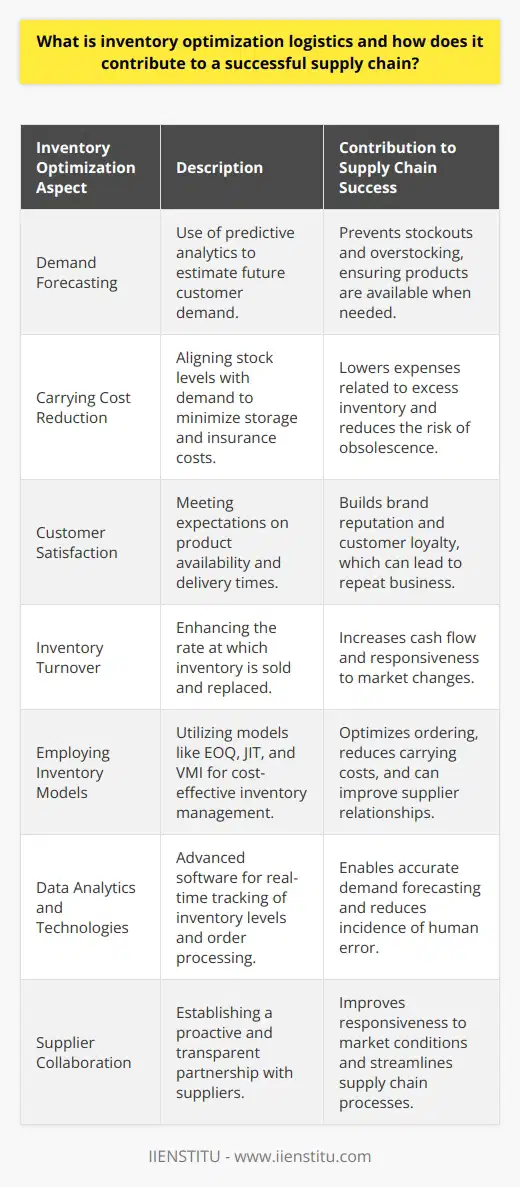
How do you monitor stock levels in logistics to ensure optimal order fulfillment and customer satisfaction?
Monitoring Methods for Stock Levels
One effective method to monitor stock levels is employing real-time tracking systems that provide clear insights into inventory levels. By leveraging advanced technologies like Radio Frequency Identification (RFID) and barcode scanning, businesses can continuously track and update stock information in their logistics operations, ensuring accurate and up-to-date data.
Stock Replenishment Strategies
Applying systematic and data-driven replenishment strategies helps maintain optimal stock levels in logistics. Techniques like Economic Order Quantity (EOQ), Just-In-Time (JIT) inventory management, and regular reviews of reorder points enable businesses to identify when to replenish stock, avoiding overstocking or stockouts. These strategies ensure a smooth flow of products and prevent disruptions in order fulfillment, ultimately increasing customer satisfaction.
Demand Forecasting and Planning
Incorporating accurate demand forecasting into logistics operations is key to monitoring stock levels effectively. By analyzing historical data, seasonal trends, and market factors, businesses can anticipate fluctuations in customer demand and adjust inventory levels accordingly. Moreover, incorporating cutting-edge technologies like artificial intelligence (AI) and machine learning in demand planning allows for improved accuracy and adaptability, enabling better control over stock levels and more efficient order fulfillment.
Collaboration with Suppliers and Partners
Establishing strong relationships with suppliers and logistics partners is essential for maintaining optimal stock levels. Effective communication and cooperation facilitate better visibility and control over the entire supply chain, from product sourcing to delivery. Implementing collaborative platforms and sharing inventory data with partners allows for proactive inventory management, ensuring timely stock replenishment and avoiding order delays.
Continuous Evaluation and Improvement
Lastly, regularly assessing and refining inventory management processes helps businesses maintain optimal stock levels in logistics. By identifying inefficiencies, potential bottlenecks, and areas for improvement, businesses can adjust their approach and streamline operations. Continuous evaluation supports a proactive, agile inventory management strategy, contributing to optimal order fulfillment and enhanced customer satisfaction.
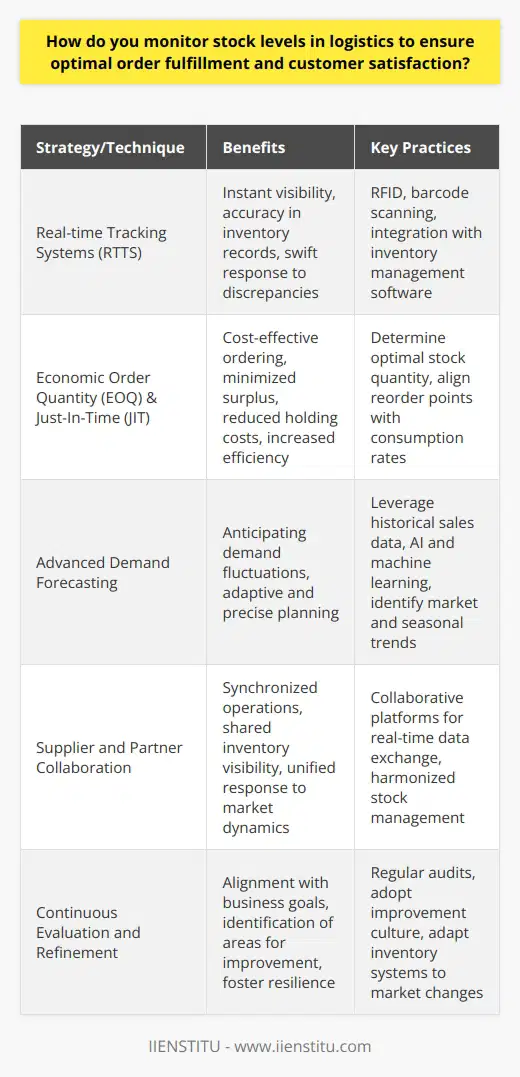
How do you optimize logistics operations to ensure effective cost and time management throughout the supply chain?
**Identifying Key Areas for Optimization**
To optimize logistics operations for effective cost and time management throughout the supply chain, it is crucial to identify key areas where efficiency can be improved. These areas may include transportation, inventory management, warehousing, and information systems.
**Improving Transportation Efficiency**
Improving transportation efficiency is essential as it directly affects both cost and time management. This may involve selecting the most suitable transportation mode, optimizing shipment routes, and consolidating shipments to minimize idle time and save on fuel costs.
**Streamlining Inventory Management**
Optimizing inventory management may lead to cost savings and effective time management. It is important to strike a balance between having sufficient stock to meet customer demands and avoiding overstocking that may result in increased storage costs and obsolescence.
**Enhancing Warehouse Operations**
Efficient warehouse operations contribute to the overall optimization of logistics operations. This may include implementing strategies such as just-in-time delivery, cross-docking, and improving warehouse layout to reduce bottlenecks and move products more efficiently.
**Integrating Information Systems**
The integration of information systems plays a vital role in optimizing logistics operations. By adopting technology solutions, such as supply chain management software and tracking tools, organizations can enhance visibility, minimize delays, and make data-driven decisions to improve cost and time management.
**Collaborating with Supply Chain Partners**
Collaboration with supply chain partners is an essential aspect to consider when optimizing logistics operations. Building strong relationships with suppliers, carriers, and other stakeholders can lead to cost savings through pooled resources, economies of scale, and shared best practices.
**Implementing Continuous Improvement Programs**
Lastly, adopting continuous improvement programs can drive long-term optimization of logistics operations. By regularly evaluating performance and identifying areas for improvement, organizations can stay competitive and progressively enhance cost and time management throughout the supply chain.
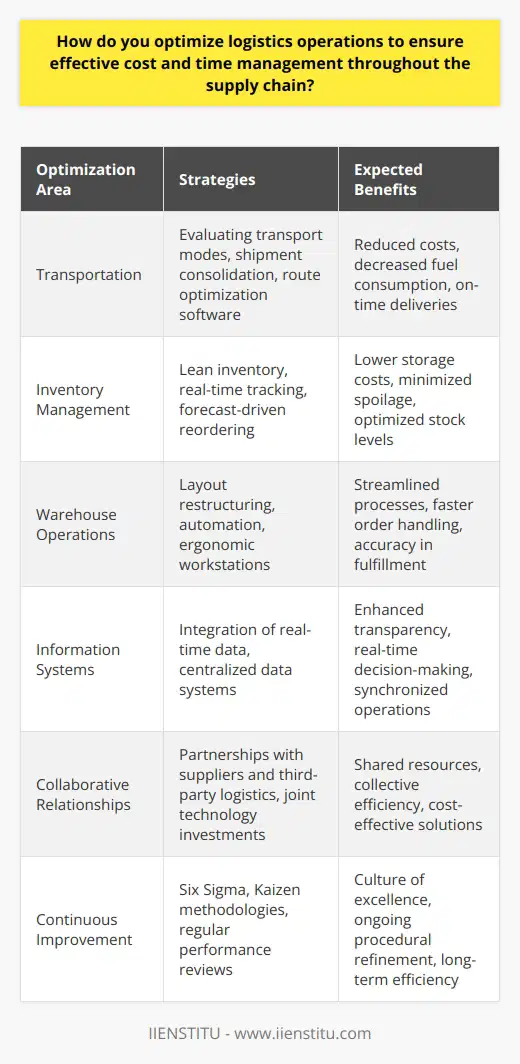
What are the crucial factors to consider when implementing optimization strategies in logistics processes?
Key Factors in Optimization Strategy Implementation
Effective optimization strategies in logistics processes necessitate the consideration of various crucial factors, which we discuss below.
Scalability and Flexibility
First, the scalability and flexibility of the optimization strategy are of paramount importance. It should be adaptable to accommodate changes in business operations or market requirements, ensuring that the logistics process can expand and adjust as needed.
Real-time Data Analysis
Logistics optimization relies on accurate, real-time data analysis from different data sources, such as GPS tracking, sensors, and software platforms. This information supports decision-makers in adjusting and improving the overall logistics process.
Collaboration and Integration
Collaboration between various stakeholders, including suppliers, transporters, and customers, is essential for streamlined logistics processes. Integration of technology between all parties ensures seamless communication and sharing of crucial data, enabling effective decision-making and reducing operational errors.
Cost-effectiveness
Optimization strategies must be cost-effective to implement and maintain. Decision-makers should thoroughly analyze short-term and long-term costs involved in the logistics processes, identifying potential areas for cost reductions and increased efficiency.
Customer Experience
A successful optimization strategy must prioritize customer satisfaction. Factors such as timely delivery, accurate tracking, and clear communication are essential to meet customers' expectations, and any strategy must focus on improving these elements.
Environmental Impact
Finally, an organization must be environmentally conscious in implementing logistics optimization strategies. This involves considering the environmental implications of the strategies, such as reduced fuel consumption, use of sustainable materials, and minimizing waste.
In conclusion, when implementing optimization strategies in logistics processes, organizations must consider scalability and flexibility, real-time data analysis, collaboration and integration, cost-effectiveness, customer experience, and environmental impact. By focusing on these crucial factors, a business can develop and maintain an efficient, sustainable logistics process that satisfies customers, reduces costs, and minimizes its ecological footprint.
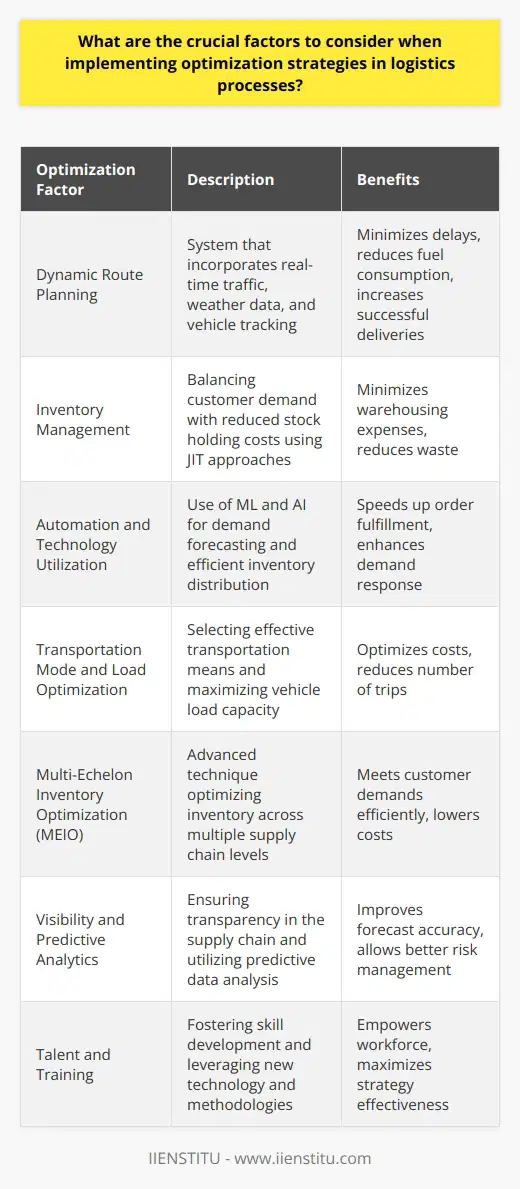
How do the 4 key processes of logistics operations contribute to the overall efficiency and competitiveness of a supply chain?
Role of Logistics Operations in Supply Chain Efficiency
Smooth Flow of Materials and Products
Efficient logistics operations involve the smooth movement of materials and finished products through the supply chain. This ensures that businesses receive the goods they need on time, which helps in maintaining production schedules, meeting customer demands, and reducing the amount of stock that companies need to hold.
Optimized Storage and Warehousing
Another essential aspect of logistics operations is the optimization of storage and warehousing facilities. This involves the strategic placement of distribution centers, effective warehouse management systems, and the use of modern technology to minimize the costs of storage, while ensuring that products are readily available when needed.
Integration of Information Systems
Information is crucial to the success of any supply chain. The integration of information systems in logistics operations enables real-time tracking of inventory levels, order processing, and shipment status. This allows for a better understanding of the supply chain, helps in making informed decisions, and enables businesses to respond quickly to changing market conditions.
Reduction of Transportation Costs
Lastly, the reduction of transportation costs plays a key role in enhancing the overall competitiveness of a supply chain. Efficient logistics operations utilize advanced transportation methods, such as intermodal freight transportation, to minimize costs and reduce lead times. Additionally, optimizing transportation routes and adopting sustainable shipping practices contribute to reduced operational expenses and a more eco-friendly supply chain.
In conclusion, the four key processes of logistics operations contribute significantly to the overall efficiency and competitiveness of a supply chain. By ensuring the smooth flow of materials and products, optimizing storage and warehousing, integrating information systems, and reducing transportation costs, businesses can build a strong supply chain that supports growth and profitability.

What is the role of advanced technologies, such as artificial intelligence and machine learning, in improving logistics optimization and inventory management?
The Increasing Significance of Advanced Technologies in Logistics and Inventory Management
Artificial intelligence (AI) and machine learning (ML) play a crucial role in enhancing logistics optimization and inventory management by automating critical processes, reducing costs, and increasing efficiency. Their implementation leads to significant improvements in various aspects of inventory and logistics management, such as demand forecasting, routing optimization, and warehouse automation.
Demand Forecasting Accuracy
The application of AI and ML algorithms allows for more accurate demand forecasting, enabling businesses to better understand consumer demand patterns. Accurate predictions help to ensure the right quantities of products are available, reducing excess inventory and stockouts. Consequently, this optimization translates to cost savings, improved customer satisfaction, and increased revenue.
Routing Optimization for Efficient Transportation
In logistics, optimizing transportation routes is essential to save time, reduce fuel consumption, and enhance delivery efficiency. With AI and ML, more sophisticated routing algorithms can be developed, considering real-time traffic data, vehicle constraints, and other factors. These advanced technologies aid in determining the most efficient routes, thereby minimizing costs while improving overall service quality.
Warehouse Automation for Increased Efficiency
The integration of AI and ML in warehouse management systems has led to the automation of various tasks, such as inventory tracking, returns processing, and order picking. By employing robotic process automation and ML-based decision-making, businesses can enhance the accuracy and speed of their warehouse operations. This automation streamlines the supply chain, providing faster turnaround times while simultaneously reducing the likelihood of human error.
In conclusion, advanced technologies, such as artificial intelligence and machine learning, have the potential to revolutionize logistics optimization and inventory management. By increasing accuracy, reducing costs, and streamlining operations, businesses can achieve greater efficiency in their supply chains, ultimately leading to an improved competitive edge and long-term success.
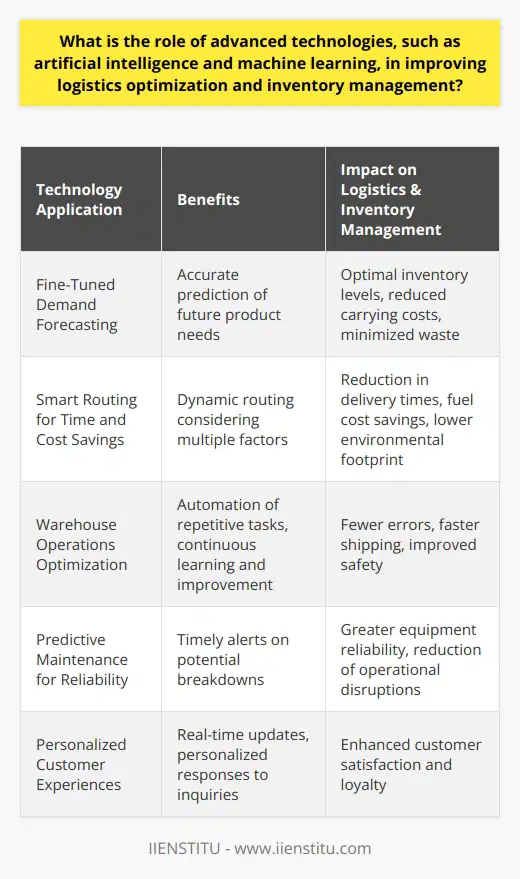
How do you assess the performance of logistics management and inventory control systems, and how can they be continuously improved?
Evaluating Logistics Management Systems
To assess the performance of logistics management and inventory control systems, the evaluation should focus on key performance indicators (KPIs) that measure the efficiency and effectiveness of the systems. These KPIs may include order fulfillment time, transportation cost per shipment, inventory turn rate, order cycle time, and stock availability, among others. By analyzing these indicators, companies can determine how well their logistics and inventory control systems are performing and identify areas for improvement.
Implementing Continuous Improvement
Continuous improvement can be achieved through regular review and adjustment of the KPIs. A cycle of planning, implementation, measurement, and review encourages the constant optimization of processes to improve efficiency and effectiveness. An organization should establish benchmarks based on industry best practices and compare their KPIs against these benchmarks to identify possible issues within their logistics and inventory control systems.
Applying Technology and Automation
One way to enhance the performance of logistics and inventory control systems continuously is by incorporating technology and automation. The use of modern tools, such as warehouse management systems (WMS) and transportation management systems (TMS), helps streamline operations, resulting in reduced errors and increased efficiency. Moreover, implementing automation technologies such as robotics, automated storage and retrieval systems (AS/RS), and artificial intelligence (AI) can further optimize the overall process.
Fostering Collaboration and Integration
Another necessary component in continuously improving logistics and inventory control systems is promoting collaboration and integration among the various functions and departments within an organization. Establishing a cross-functional team, comprising representatives from procurement, warehouse management, transportation, and other relevant departments, encourages close collaboration and joint problem-solving, ultimately leading to more effective strategies and improved system performance.
Investing in Employee Training
Lastly, investing in employee training and development is essential in ensuring the success of logistics management and inventory control systems. Regularly updating employees with the latest industry trends and technologies, along with practical training and skill development, ensures that they are well-equipped to contribute towards continuous improvement efforts within the organization.
In conclusion, performance assessment of logistics management and inventory control systems should focus on key performance indicators that measure overall efficiency and effectiveness. Continuous improvement initiatives can be achieved by reviewing and adjusting these KPIs regularly, implementing technology and automation, fostering collaboration and integration, and investing in employee training and development.

What is the impact of implementing sustainable and eco-friendly practices in logistics optimization and inventory management on overall supply chain efficiency?
Impact on Overall Efficiency
Implementing sustainable and eco-friendly practices in logistics optimization and inventory management has a significant impact on the overall efficiency of the supply chain. Through these practices, companies can reduce costs, improve operational performance, and contribute to environmental preservation efforts.
Reduced Costs
One of the main benefits of adopting sustainable practices is cost reduction. By optimizing transportation routes, conserving fuel, and reducing packaging waste, companies can achieve better resource utilization, which directly results in decreased operational expenses. Moreover, various governmental incentives encourage businesses to adopt sustainable practices, further enhancing the overall cost savings.
Operational Performance
Sustainable and eco-friendly measures also result in improved operational performance. Implementing green practices, such as energy-saving technologies, efficient warehouse layout, and waste reduction strategies, can help companies enhance their productivity. Furthermore, these practices can foster better collaboration among supply chain partners, leading to better inventory management and timely order fulfillment.
Environmental Preservation
Adopting sustainable practices in logistics and inventory management also leads to a positive impact on the environment. By reducing emissions through the use of efficient transportation methods and decreasing waste in packaging and warehousing processes, businesses can significantly reduce their carbon footprint. This, in turn, contributes to combating climate change and maintaining an ecological balance.
Stakeholder Engagement
Implementing eco-friendly practices also benefits companies in terms of stakeholder engagement. Customers and investors are increasingly mindful of sustainability concerns and prefer to engage with businesses that prioritize environmental stewardship. Adopting sustainable practices in logistics and inventory management can improve a company's reputation and appeal to eco-conscious stakeholders.
Conclusion
In conclusion, implementing sustainable and eco-friendly practices in logistics optimization and inventory management has a considerable impact on the overall efficiency of the supply chain. These practices enable businesses to reduce costs, improve operational performance, contribute to environmental preservation efforts, and enhance stakeholder engagement. Thus, embracing sustainability in logistics and inventory management is essential for businesses to thrive in today's increasingly competitive and environmentally conscious market.
